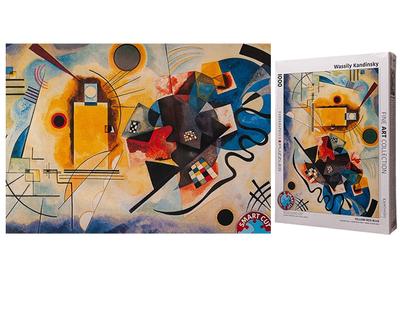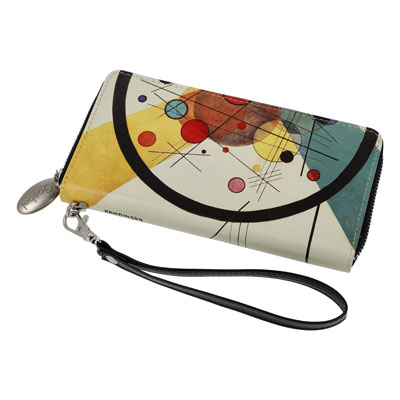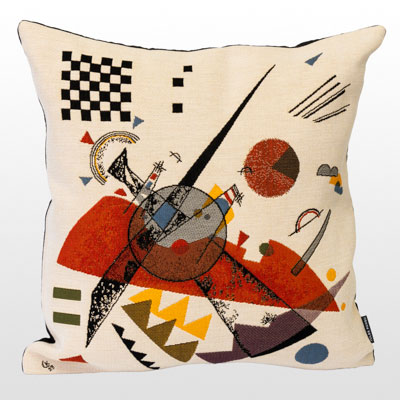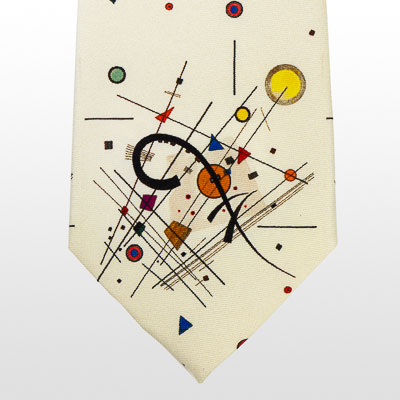Tel : (+33) 4 94 63 18 08
9am - 6pm from Monday to Sunday
All products Wassily Kandinsky • Products of the topic Abstract
Kandinsky tapestry - For and Against (1929)
REF : WK-TAPI-02
In stock
Only 1 in stock
Unavailable
250,00 €
(270.52 USD)
Vassily Kandinsky tapestry : "For and Against (1929)"
Dimensions : 100 x 70 cm
Composition : 98% Coton
This genuine tapestry is woven in cotton on authentic Jacquard looms, allowing for tight and fine weaving points.
Each tapestry is executed with unique craftsmanship, using noble materials, primarily cotton, to guarantee exceptional quality.
Made in Flanders, a renowned region for its weaving expertise, this tapestry is the result of meticulous artisanal work.
The beautiful finishes add a touch of elegance and sophistication to this unique piece of art.
Each tapestry is accompanied by its certificate of authenticity, guaranteeing its origin and artistic value.
Ready to be hung on the wall, this tapestry is equipped with an integrated sleeve in the lining, making installation easy and giving it a neat appearance once suspended (please note that the display rod shown in the photo is not included).
To preserve its beauty and quality, it is recommended to dry clean only, in order to maintain the fine details and vibrant colors.
Bauhaus
The Bauhaus art movement (which means 'the house of construction'), created in 1919 in Weimar, Germany, is an art and design school founded by a group of visionary artists, including Walter Gropius, Paul Klee, Wassily Kandinsky, and Ludwig Mies van der Rohe. The Bauhaus sought to unify applied arts and fine arts, promoting a holistic approach to artistic creation. The Bauhaus moved successively to Dessau and Berlin during its 14 years of existence. Its goal was to bring together traditional craftsmanship and industrial techniques to create functional, aesthetic, and innovative artworks. The artists of Bauhaus explored new forms, clean lines, vibrant colors, and geometric aesthetics, influencing architecture, design, painting, and sculpture. The Bauhaus also placed great importance on education, encouraging an experimental and collaborative approach. Students benefited from a comprehensive curriculum, allowing them to explore various artistic disciplines, including woodworking, ceramics, photography, weaving, and typography. This interdisciplinary approach gave rise to a new generation of innovative artists and designers who helped shape the artistic and cultural landscape of the 20th century.
Discover the artist
Kandinsky Wassily
Wassily Kandinsky was a painter, art theorist, who taught at the Bauhaus and died in Neuilly sur Seine in 1944, after taking French nationality.
Founder of abstract art, he only started painting very late, at the age of thirty. It was in Munich that he began his training, where he founded the Blaue Reiter with in particular Franz Marc, putting into practice his reflections on the abstraction which is the expression of the inner spirituality of the painter.
After the Revolution, he returned to his country, but his freedom as a painter being questioned by the supporters of the Bolshevik regime, he returned to Germany. He then joined the Bauhaus where the plastic arts and the applied arts interpenetrate to give birth to a complete vision of art.
He left Germany when the Bauhaus was dissolved in 1933 and settled in Paris. There, more lonely, he built the synthesis of his art with in particular the famous Composition IX.
Kandinsky Wassily
Wassily Kandinsky was a painter, art theorist, who taught at the Bauhaus and died in Neuilly sur Seine in 1944, after taking French nationality.
Founder of abstract art, he only started painting very late, at the age of thirty. It was in Munich that he began his training, where he founded the Blaue Reiter with in particular Franz Marc, putting into practice his reflections on the abstraction which is the expression of the inner spirituality of the painter.
After the Revolution, he returned to his country, but his freedom as a painter being questioned by the supporters of the Bolshevik regime, he returned to Germany. He then joined the Bauhaus where the plastic arts and the applied arts interpenetrate to give birth to a complete vision of art.
He left Germany when the Bauhaus was dissolved in 1933 and settled in Paris. There, more lonely, he built the synthesis of his art with in particular the famous Composition IX.
Kandinsky Wassily
Wassily Kandinsky was a painter, art theorist, who taught at the Bauhaus and died in Neuilly sur Seine in 1944, after taking French nationality.
Founder of abstract art, he only started painting very late, at the age of thirty. It was in Munich that he began his training, where he founded the Blaue Reiter with in particular Franz Marc, putting into practice his reflections on the abstraction which is the expression of the inner spirituality of the painter.
After the Revolution, he returned to his country, but his freedom as a painter being questioned by the supporters of the Bolshevik regime, he returned to Germany. He then joined the Bauhaus where the plastic arts and the applied arts interpenetrate to give birth to a complete vision of art.
He left Germany when the Bauhaus was dissolved in 1933 and settled in Paris. There, more lonely, he built the synthesis of his art with in particular the famous Composition IX.
Kandinsky Wassily
Wassily Kandinsky was a painter, art theorist, who taught at the Bauhaus and died in Neuilly sur Seine in 1944, after taking French nationality.
Founder of abstract art, he only started painting very late, at the age of thirty. It was in Munich that he began his training, where he founded the Blaue Reiter with in particular Franz Marc, putting into practice his reflections on the abstraction which is the expression of the inner spirituality of the painter.
After the Revolution, he returned to his country, but his freedom as a painter being questioned by the supporters of the Bolshevik regime, he returned to Germany. He then joined the Bauhaus where the plastic arts and the applied arts interpenetrate to give birth to a complete vision of art.
He left Germany when the Bauhaus was dissolved in 1933 and settled in Paris. There, more lonely, he built the synthesis of his art with in particular the famous Composition IX.
Kandinsky Wassily
Wassily Kandinsky was a painter, art theorist, who taught at the Bauhaus and died in Neuilly sur Seine in 1944, after taking French nationality.
Founder of abstract art, he only started painting very late, at the age of thirty. It was in Munich that he began his training, where he founded the Blaue Reiter with in particular Franz Marc, putting into practice his reflections on the abstraction which is the expression of the inner spirituality of the painter.
After the Revolution, he returned to his country, but his freedom as a painter being questioned by the supporters of the Bolshevik regime, he returned to Germany. He then joined the Bauhaus where the plastic arts and the applied arts interpenetrate to give birth to a complete vision of art.
He left Germany when the Bauhaus was dissolved in 1933 and settled in Paris. There, more lonely, he built the synthesis of his art with in particular the famous Composition IX.












































































































